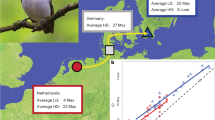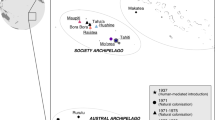Abstract
THE observations of D. and E. Lack1 on a southerly migration of insects in October 1950 at Port de Gavarnie in the Pyrenees, which has since been confirmed in October 1951 by Messrs. D. W. Snow and K. F. A. Ross2 and others, makes possible a hypothetical interpretation of migration on a genetic basis for the first time. They observed between a hundred and five hundred butterflies per hour (Colias croceus, Vanessa atalanta and Pontia daplidice), one thousand to five thousand dragonflies (Sympetrium striolatium striolatium), and the syrphid fly (Episryphus balteatus), “at least twenty times and perhaps one hundred times as common as the dragonflies” flying in a southerly direction. Dr. C. B. Williams3 has for many years shown a southerly migration in Vanessa atalanta and more recently in C. croceus in Great Britain in the autumn, and the southerly migration of D. plexippus is a well-known fact in North America.
This is a preview of subscription content, access via your institution
Access options
Subscribe to this journal
Receive 51 print issues and online access
$199.00 per year
only $3.90 per issue
Buy this article
- Purchase on Springer Link
- Instant access to full article PDF
Prices may be subject to local taxes which are calculated during checkout
Similar content being viewed by others
References
Lack, D., and Lack, E., J. Animal Ecol., 20, 63 (1951).
Snow, D. W., and Ross, K. F. A., Ent. Mon. Mag., 88, 1 (1952).
Williams, C. B., Trans. Roy. Ent. Soc., Lond., 92, 240 (1942); J. Animal Ecol., 20, 180 (1951).
Heape, W., “Emigration, Migration and Nomadism” (Cambridge, 1931).
Kettlewell, H. B. D., Proc. Trans. S. Lond. Ent. Nat. Hist. Soc., 1943–44, 69 (1944).
Kettlewell, H. B. D., Proc. Roy. Ent. Soc. Lond., C 12, 43 (1947).
Hovanitz, W., Contr. Lab. Vert. Biol. Univ. Mich. No. 41 (1948).
Jarvis, F. V. L., Proc. Trans. S. Lond. Ent. Nat. Hist. Soc., 1941–42, pt. 1, 1 (1941).
Author information
Authors and Affiliations
Rights and permissions
About this article
Cite this article
KETTLEWELL, H. A Possible Genetic Explanation and Understanding of Migration of Continuous Brooded Insects. Nature 169, 832–833 (1952). https://doi.org/10.1038/169832b0
Issue Date:
DOI: https://doi.org/10.1038/169832b0
This article is cited by
-
10.1007/BF00422023
CrossRef Listing of Deleted DOIs (2011)
-
Flight and flight control by the antennae in the Small Tortoiseshell (Aglais urticae L., Lepidoptera)
Journal of Comparative Physiology ? A (1981)
Comments
By submitting a comment you agree to abide by our Terms and Community Guidelines. If you find something abusive or that does not comply with our terms or guidelines please flag it as inappropriate.



